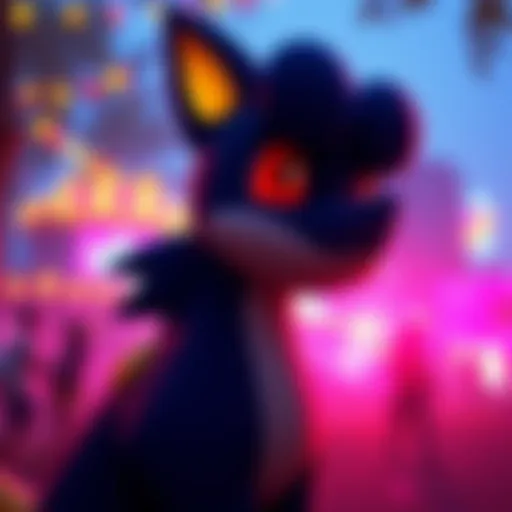Exploring the Depths of Skyrim's Universe


Intro
In the vast expanse of Tamriel, there lies a world brimming with stories, mysteries, and immersive experiences. Skyrim, crafted by Bethesda Game Studios, is not just a game; it’s a monument to the role-playing genre. Since its release in 2011, it has captured the hearts of players with an intricate web of lore, dynamic gameplay, and a richly woven tapestry of character development. This article aims to provide a thorough exploration of what makes Skyrim an enduring classic, while also looking at the culture that has blossomed around it— from the dedicated modding community to the impact it has had on the gaming industry as a whole.
Whether you’re charting the icy paths of the Throat of the World or engrossed in a quest that’s taken you deep underground, every corner of Skyrim offers new adventures. It is not just the gameplay elements that shine, but also the connectivity between its various systems that keeps players engaged long after they’ve rolled credits.
This comprehensive overview will guide you through Skyrim’s unique gameplay mechanics, artistic design choices, and the intricate lore that defines its world.
Game Feature Spotlight
Unique Gameplay Mechanics
At the crux of Skyrim’s appeal lies its unique gameplay mechanics, which offer players an impressive degree of freedom. Unlike many traditional RPGs that guide players down a linear path, Skyrim encourages exploration and personal choice. The mechanic of skill leveling ensures that players can develop their character in whichever direction suits their playstyle, whether they choose to favor archery, magic, or melee combat. This flexibility cultivates a personal connection to the character you create.
Another notable feature is the Dragon Shout system, which infuses combat with a sense of power and majesty. Each shout, or Thu'um, serves as a reminder of the mystical heritage of the Dragonborn. Acquiring these shouts requires exploration and quest completion, thus tying Skyrim’s mechanics to its expansive narrative.
Art Style and Design
The visual design of Skyrim is nothing short of breathtaking. The sprawling landscapes, from the snow-capped mountains to the lush fields, evoke a sense of realism rarely seen in video games. Each region of Skyrim has its own distinct feel and ambience, reflecting the cultural diversity of its inhabitants.
To appreciate this depth in design, one might explore the architectural styles of Whiterun, famed for its medieval Nordic buildings, as opposed to the more imperial design of Solitude. Subtle details like these enrich the player’s experience by creating an authentic world that feels lived in.
"Good design is as little design as possible." – Dieter Rams
Storyline and Characters
At the heart of Skyrim is an intricate narrative that simultaneously weaves multiple storylines and character arcs. Players are thrust into a world at the precipice of chaos, where the return of dragons threatens the very existence of the realm. This overarching quest is complemented by numerous side quests, each filled with rich storytelling and character development.
The characters you encounter, from the noble Ulfric Stormcloak to the whimsical M'aiq the Liar, are more than just mere NPCs; they are vessels of stories and history that enhance the lore of Tamriel. This narrative depth invites players not just to engage in combat, but to forge connections, make moral choices, and truly inhabit the world of Skyrim.
Despite being set in a fantasy realm, Skyrim’s narratives often reflect real-world dilemmas, encouraging players to think critically about their actions and decisions.
As we continue through this exploration, let’s delve deeper into specific aspects that make this game a unique phenomenon.
Intro to Skyrim
The journey into the world of Skyrim begins with an appreciation of its rich history and the milestones that have crafted its status within the gaming realm. The significance of this introduction lies in understanding how Skyrim has transcended from a mere video game to a cultural touchstone—a phenomenon that extends beyond pixels and programming.
In exploring this section, players new and seasoned alike can glean insights into the game’s origins, the immersive landscapes it offers, and the fervent community that rallies around it. So as we peel back the layers of Skyrim, we uncover not just a game but an experience that fosters creativity, exploration, and storytelling.
The Cultural Phenomenon of Skyrim
There’s no denying that Skyrim isn’t just a game—it's a cultural landmark. Since its launch, it has forged a unique path in video game history, pulling in millions of players of various ages and backgrounds. Songs about the game have even hit the charts, and memes are a dime a dozen on social media. The entirety of Skyrim—from the dragon shouts to the graceful Nordic landscapes—has seeped into the collective consciousness of the gaming community.
As players wander across the snow-capped mountains or delve into dungeons filled with draugr, they embark on stories that feel as real as life itself. It’s this blend of lore, visual artistry, and the freedom to create one's narrative that transforms Skyrim from a simple RPG to a shared experience reflecting our personal tales and aspirations. The powerful impact of this phenomenon stretches across platforms like Reddit and various fan forums, acting as communal spaces for discussions that enrich the game’s lore and shared experiences.
Release and Reception
Released in November 2011 by Bethesda Game Studios, Skyrim garnered critical acclaim from the outset. Review scores soared, highlighting not just its expansive open world but also its intricate systems, storytelling techniques, and replayability. Over time, it has won multiple Game of the Year awards, clearly solidifying its reputation in the industry.
However, the reception has been more than just numerical values. Player reactions were overwhelmingly positive, with many praising how it skillfully married rich narrative with expansive freedom. This was not just another title to toss on the shelf; it became a platform for creativity. The game breathed life into mods, which have allowed players to expand their adventures into celestial realms or dark dystopias, significantly impacting even the reception of subsequent titles in the series.
The enduring success of Skyrim is evidenced by its continued release across various platforms, including the enhanced Special Edition and the Nintendo Switch version. Each version reinforces the game's adaptability and relevance in a fast-paced technological era.
"Skyrim may be a fantasy, but its impact on the real world is profoundly felt in both gaming and culture itself."
In summation, the introduction to Skyrim acts as the foundation upon which we will build a comprehensive understanding of its many facets. Teeming with life, mystery, and community, the exploration of Skyrim promises to reveal a treasure trove of insights, stories, and ongoing legacy that resonates with gamers young and old.
The Skyrim Experience
The Skyrim Experience is at the very heart of what has made this game a beloved classic among gamers. It transcends mere gameplay, inviting players into a vibrant world filled with rich narratives and endless exploration. One of the most compelling aspects of this experience is how it allows individuals to lose themselves in the detailed landscapes and diverse cultures of Tamriel. In this section, we’ll delve into the multifaceted elements of this experience, from open-world exploration to character customization, both of which are fundamental for any player seeking to make their mark in Skyrim.
Open World Exploration
Landscapes and Environments


When you step into Skyrim, the first thing that usually strikes you is the stunning diversity of landscapes. Imagine towering snow-capped mountains standing guard over serene forests and sprawling plains. It's not just eye candy; the environments are meticulously crafted to evoke a sense of immersion. Every nook and cranny has something to offer, whether it's a hidden cave or a quaint village filled with characters waiting to share their stories.
One of the key characteristics of these landscapes is their dynamic interplay with the game's lore. Each area is steeped in history, with ruins and landmarks telling tales of past civilizations. This contributes greatly to the overall topic by allowing players to explore while learning about the world around them. The unique feature here is the ability to get lost both literally and figuratively; players might start exploring a quaint town only to find themselves stumbling upon a plot that drags them into a hidden quest arc that they never anticipated.
However, it's worth noting that while the landscapes are visually stunning, they can sometimes lead to disorientation for new players. Navigating the vast expanse without a map can feel overwhelming at first, although many find this sense of adventure to be refreshing and rewarding.
Dynamic Weather System
The Dynamic Weather System in Skyrim is another layer that amplifies the immersive experience of the game. Picture this: you’re deep in the woods near Whiterun, and suddenly, dark clouds roll in, followed by a torrential downpour. The atmosphere changes; the colors seem more vibrant, and the sounds of rain create a cocoon of realism. This kind of weather variability affects not just the aesthetics but also gameplay.
A standout characteristic of this weather system is its ability to impact visibility and movement. Heavy snow might limit your vision, making ambushing foes more challenging. This capability allows for tactical advantages and encourages players to think on their feet, bolstering engagement with the environment.
Yet, the weather isn't always in your favor. The unpredictability means you might find yourself in a tight spot during an essential moment, which can be both thrilling and frustrating. Despite that, it’s an aspect that many players appreciate for its contribution to the sense of realism and immersion.
Character Customization
Races and Abilities
Character customization in Skyrim offers a treasure trove of possibilities. Each race you choose comes with its own set of unique abilities, which significantly influences gameplay. Be it the stealthy Khajiit or the brute strength of an Orc, your choice shapes not only your character's skills but also your initial experience in the game.
This diversity in Races and Abilities is a primary factor for many players who seek to tailor their adventures. It enables various playstyles, allowing each player to design a character that corresponds closely with their preferred approach to challenges. The distinctive abilities that come with each race add depth, ensuring that whether you prefer brawling or casting spells, there’s a fitting race for your desired gameplay.
However, it’s not without its complexities; new players may find the initial choices overwhelming with so many options available. They might struggle early on to pinpoint which abilities align best with their style but discovering these nuances can lead to a satisfying journey of trial and error.
Skill Progression and Perks
Once the race is chosen, you dive into Skill Progression and Perks, which adds yet another layer to character personalization. As players engage in combat, crafting, or other activities, their skills increase, paving the way for enhanced abilities. This unique feature empowers individuals to follow a path that aligns with their interests, allowing for a level of growth that can lead to a deeply satisfying sense of accomplishment.
The perk system is what truly distinguishes Skyrim's character development. Players can unlock specific bonuses that significantly enhance their character's abilities. This can be particularly appealing to those who relish the idea of creating a master thief or a powerful sorcerer. The flexibility of progression fosters different approaches to quests and challenges, making the experience richer and more varied.
Of course, this system might feel daunting for some. Deciding which perks to unlock can create a sense of pressure, especially with the looming possibility of making poor choices. Yet, this nuanced design challenges players to think critically about their decisions, enhancing strategic gameplay.
The eye for detail in the characters you create and the worlds you explore is unparalleled. The breadth of systems at play ensures that no two adventures are alike.
With its rich world and dynamic gameplay, the Skyrim Experience immerses players in a way that few other games can. The exploration of diverse environments and the freedom in character development lend themselves to crafting uniquely personal stories that resonate long after the final quest is completed.
Tools of the Trade
In the expansive universe of Skyrim, the tools a player chooses can significantly shape their adventure. Weapons, armor, magic, and shouts serve as the backbone of gameplay, melding together to create an intricate system that enhances each quest and exploration. The choices players make with these tools not only affect combat effectiveness but also influence interaction with the world and its characters. Understanding how these elements work together is key to mastering the game.
Weapons and Armor
Crafting and Enchanting
Crafting and enchanting in Skyrim is a craft that can transform even the most mundane weapons into formidable tools. The process involves collecting materials—like iron ingots or dragon bones—and then utilizing them to forge weapons or armor at various forges across the land. This ability to shape gear is a hallmark of Skyrim, allowing players to tailor their arsenal to fit their preferred playstyle. The intricate enchantment system adds another layer, enabling players to imbue their creations with magical properties. For instance, a sword can be enchanted to absorb health, providing sustainability during battles.
One key characteristic of crafting is its adaptability. Players can focus on creating light armor for stealth-based characters or heavy armor for those who prefer tanking damage. This flexibility promotes a sense of ownership over one's character, as every crafted item is imbued with the player’s unique touch. However, there are drawbacks. Crafting requires time and resources, which might deter those who want a quicker pace. Moreover, enchanted items are limited by the skill level; higher levels unlock more powerful enchantments, which can be a grind.
- Advantages:
- Disadvantages:
- Personalization of gear
- Increases character efficiency
- Encourages gathering resources to enhance skills
- Resource-intensive
- Can be time-consuming
Legendary Items
Legendary items in Skyrim are the crown jewels of the game’s arsenal. These unique pieces often come with rich backstories connected to the lore of Tamriel, augmenting the experience for players who relish story-rich treasure hunts. For example, items like the Daedric Armor or the Umbra Sword are not only powerful but also steeped in narrative significance. Tracking them down usually entails completing challenging quests that test a player’s versatility.
The hallmark of legendary items is their rarity and potency. These gear pieces frequently offer benefits beyond mere stats, such as abilities that can turn the tide of battle. Legendary gear often requires meticulous quests or defeating iconic enemies, adding an extra layer of satisfaction when they're earned.
Nonetheless, this comes with a caveat. Some players may find that the best legendary items don’t appear until late-game, meaning new players may miss out on them initially, potentially making the early game feel less rewarding.
- Advantages:
- Disadvantages:
- Powerful abilities and enhancements
- Tied to lore which enriches the narrative experience
- Offers a sense of achievement
- Harder to obtain
- May not suit every playstyle


Magic and Shouts
Schools of Magic
Magic in Skyrim is segmented into various schools, each presenting unique forms of spells. Players can dabble in Destruction, Healing, Alteration, and more, allowing for a diverse playstyle. For instance, destruction spells can rain fire upon enemies, while healing spells can keep a player alive in fierce combat situations. This variety gives players the freedom to experiment, encouraging them to find spells that suit both their tactics and story role.
A significant aspect of schools of magic is their resource management. Each spell costs magicka, which regenerates over time but can be depleted rapidly in longer fights. This characteristic challenges players to strategize when to unleash their more potent spells, adding depth to combat scenarios. It caters to both scholars who prefer a tactical approach and those favoring brute force.
- Advantages:
- Disadvantages:
- Varied combat styles through diversified spells
- Encourages strategic gameplay and resource management
- Requires understanding of mechanics to be effective
- Regeneration may restrict lengthy spellcasting
The Thu'um Language
The Thu'um, or Dragon Shouts, represents one of the most engaging features of Skyrim’s magic system. It allows players to unleash powerful vocal attacks, each shout containing a unique effect, from unleashing a wave of force to summoning a dragon. The language of the dragons can only be learned through certain in-game experiences, which adds an element of discovery.
What stands out about the Thu'um is the sheer impact it can have during battles. Many of these shouts can disable, damage, or even control opponents, making them powerful tools for combat. Every player can leverage a different combination of shouts to suit their individual strategy, creating a sense of creativity in how to tackle foes.
However, mastering this ancient language is not without its challenges. Unlike spellcasting, which requires only magicka, shouts are governed by cooldowns that limit how frequently they can be used. This can lead to a catch-22 scenario where players must decide between using a shout or saving it for a more opportune moment, often adding anxiety in intense scenarios.
- Advantages:
- Disadvantages:
- Powerful against both single targets and groups
- Adds layers to combat with unique interactions
- Cooldown limits frequency of use
- Requires learning specific words of power
Conclusion:
The tools of trade in Skyrim shape playstyles and influence interactions within the game's rich tapestry. Mastering weapons, armor, magic, and shouts allows players to truly immerse themselves in the journey of Tameriel's vast world.
Intricate Questlines
The beauty of Skyrim lies not only in its vast landscapes and immersive mechanics but also in the intricate tapestry of its questlines. These narratives create a deep sense of engagement that keeps players returning time and time again. Every choice, every alliance, and even every betrayal can heavily influence the tale that unfolds, highlighting Skyrim’s dual strengths in storytelling and player agency.
Questlines in Skyrim serve multiple roles, from introducing critical lore to fostering emotional investment in characters. They act as the lifeblood of the game, enriching the gameplay with a variety of experiences that range from epic battles to moral dilemmas that test a player's resolve. A player’s journey through these intricate narratives is often where they find themselves fully immersed in the world of Tamriel.
Having an impressive balance between main and side quests enables players to dive deep into Skyrim’s lore, encouraging exploration and granting rewards that extend well beyond mere gameplay. It’s a world where every choice can lead to a completely different outcome, necessitating when and how players engage with these questlines.
Main Story Arc
The main story arc of Skyrim, which revolves around the Dragonborn and their destiny to combat the return of dragons, is nothing short of captivating. This arc not only binds the player to their character's purpose but also seamlessly integrates various factions and locales into a cohesive experience. Traveling across the province of Skyrim, players will encounter high-stakes confrontations, emerging as the only hope against Alduin, the World-Eater. The weight of the narrative adds depth to every action, with choices contingent upon player behavior.
Through engaging dialogues and significant character interactions, the main arc expertly provides exposition about the dragons and their impact on the land. Players can witness how Skyrim evolves based on their decisions, creating an intricate web of cause and effect. The main story is a vital thread that ties in the game's lore, enriching its backdrop.
Notable Side Quests
While the main quest is essential, it’s the side quests that often steal the show, weaving in a tapestry of unique stories, characters, and experiences. Two standout examples—the Companions Guild and the Civil War Arc—each contribute significantly to the fabric of Skyrim's world.
Companions Guild
The Companions Guild is a faction that embodies the spirit of camaraderie and honor. Set in the rustic and formidable city of Whiterun, it offers players the chance to engage in a narrative steeped in tradition and conflict. What sets the Companions apart is their duality; they are not merely warriors but also a band of honorable mercenaries who uphold a code of conduct.
This guild gives players the opportunity to train in combat skills while exploring unique storylines, including the transformation into a werewolf. The questline allows the player to confront moral questions about loyalty and heritage, making it an enriching choice. With multi-layered characters like Skjor and Aela, players find their choices significantly affect their standing within the guild, including the chance to delve into their ancient secrets. Moreover, joining the Companions can act as a stepping stone to other quests across Skyrim, extending the overall narrative experience.
Civil War Arc
The Civil War Arc is perhaps one of the most poignant narratives in Skyrim. Set against a backdrop of political intrigue, it involves a struggle between the Imperial Legion and the Stormcloaks, each with their ideologies about governance and freedom. This arc dives deep into themes of loyalty, betrayal, and the search for identity in a tumultuous landscape.
Choosing sides greatly impacts how the game world behaves, leading to a full-scale war that engulfs Skyrim. The unique feature of this questline is that players can embrace either faction’s ethos, enabling a truly customizable experience. In a land divided, this arc compels players to weigh their decisions carefully, understanding that their allegiance will affect the province’s fate. However, such choices can come with consequences, including strained relationships and shifting power dynamics that reverberate throughout the stories that unfold in Skyrim.
Whether players opt for the Companions Guild or venture into the Civil War Arc, engaging with these questlines allows for a richer understanding and appreciation of Skyrim's complex narrative landscape. With every quest undertaken, players not only shape their character but also influence the world around them, which is central to the experience of The Elder Scrolls V: Skyrim.
The Role of Modding in Skyrim
The world of Skyrim is not just defined by its vast landscapes and detailed lore; it is equally shaped by an enthusiastic community of modders. The role of modding in Skyrim carries a weight that goes beyond mere customizations; it's a labor of love that breathes new life into the game. Players, irrespective of age, can alter their experiences, making every journey through Tamriel feel different from the last. In this section, we'll dive into what modding is, explore some popular choices among players, and examine the tangible benefits that come with modding Skyrim.
Preface to Modding


Modding, short for "modification," refers to the practice of altering a game to enhance or change the player experience. In Skyrim, this could entail everything from new textures that improve the visual presentation of the environment to entirely new questlines that expand upon the existing storytelling.
This community-driven creation process allows for innovations that the original developers might not have considered or had the time to implement. A mod could introduce a new dragon species, a different gameplay mechanic, or even a simple quality-of-life change that makes managing inventory smoother. In essence, modding is akin to taking a superb painting and adding unique brushstrokes, giving it a personal touch and enhancing its depth.
Popular Mods
The Skyrim modding community is vast, with thousands of mods available to enhance nearly every aspect of the game. A few genres of mods, such as Graphical Enhancements and Gameplay Tweaks, are particularly notable for their popularity among gamers and their impact on the overall experience.
Graphical Enhancements
Graphical enhancements are among the most sought-after mods within the Skyrim community. This type of mod focuses on improving the visual details, making Skyrim's already stunning scenery even more breathtaking. These mods often feature high-resolution textures that ensure the mountains, forests, and cities look sharp and picturesque.
One of the key characteristics of these mods is their ability to overhaul the lighting systems in the game. For instance, mods like "RealVision" or "NobleSkyrim HD-2K" can create more realistic shadows and vibrant colors that draw players further into the game world.
However, potential downsides exist. Not all players have high-end rigs capable of handling the increased graphical load that these mods introduce, which can lead to performance issues. Even so, the enhanced beauty of the game often outweighs these concerns for many players, allowing them to appreciate the lush landscapes of Skyrim in a new light.
Gameplay Tweaks
Gameplay tweaks focus less on visual elements and more on altering mechanics to enrich the overall play. These modifications may adjust combat systems, enhance NPC interactions, or streamline skill progression. Mods like "Unofficial Skyrim Patch" address bugs and mechanical flaws that can disrupt gameplay, making every adventure in Tamriel a bit smoother.
These adjustments often come with a key characteristic—balancing game mechanics to deliver a fair yet challenging experience. A perfect example could be the mod "Skyrim Skill Uncapper," which allows players to level up skills without the traditional limitations imposed by the vanilla game.
The beauty of gameplay tweaks lies in how they cater to the preferences of individual players, allowing a tailored experience. Of course, any mod carries the risk of compatibility issues with other modifications, requiring players to be cautious when combining changes to avoid breaking their game.
"Modding serves as a bridge between players' imaginations and the steadfast world of Skyrim—creating endless possibilities for customization and deepening the gaming experience."
Skyrim's Community and Legacy
Skyrim is not just a game; it is a massive cultural phenomenon that has evolved through its vibrant community and long-lasting impact on the gaming industry. The players of Skyrim have crafted an interest that extends beyond mere gameplay into realms of creativity, discourse, and ongoing engagement. This section shines a light on those aspects and explores how Skyrim's community and legacy contribute to its enduring charm.
Online Communities and Fan Base
The online presence surrounding Skyrim is exemplary of how passionate player bases can thrive and generate meaningful interactions. Dedicated forums, subreddits, and fan sites have sprung up, creating a lively space for musing over lore theories, sharing mods, and discussing character builds. From the bustling community over on Reddit, where avid players gather to share screenshots and stories, to forums like the Elder Scrolls fan sites, these platforms serve as a melting pot of ideas and creativity.
Participating in these communities often leads to discovering unique and fascinating aspects of the game that might fly under the radar for casual players. For instance, fans delve into the extensive lore and come up with intricate backstories for characters that aren’t even fleshed out fully in the main storyline. This engagement enriches the Skyrim experience, fostering a sense of belonging and camaraderie among gamers of all ages.
Influence on Future Titles
Spiritual Successors
The effect of Skyrim on the RPG genre is monumental. Games like The Witcher 3: Wild Hunt and Dragon Age: Inquisition have drawn inspiration from the richness of Skyrim's world-building and gameplay styles. These spiritual successors take elements like vast open-world exploration and character-driven narratives and refine them to push the boundaries even further. The quests are more sophisticated, the choices more consequential, and the engagement even deeper.
In The Witcher 3, for example, players find themselves immersed in a morally ambiguous world that echoes the multifaceted nature of Skyrim. The Gwent card game within the game adds layers to gameplay, showcasing how future titles have transformed engaging mechanics from Skyrim into their own unique features. The continual computation of choices and consequences in these successors reflects their roots in Skyrim, affirming its lasting influence.
Continued Interest in RPGs
Skyrim's impact reaches further into the sustained interest in RPGs as a genre. The game's enduring appeal has rekindled interest among developers and players alike, sparking a resurgence in RPGs across platforms. Titles that prioritize choice and consequence, like Cyberpunk 2077, reflect lessons learned from Skyrim’s gameplay structure and narrative depth. Moreover, the vast modding community continues to push the envelope, creating an abundance of content that draws new players in, keeping the genre fresh.
The freedom of exploration, character customization, and immersive storytelling seen in Skyrim invites new gamers to explore RPGs, making them more accessible. However, this also presents the risk of high expectations. Players often find themselves comparing new titles to Skyrim, expecting the same depth or breadth—sometimes to their disappointment. Yet, this expectation serves as both a challenge and a healthy push for future developers to innovate and craft their own unique experiences.
Culmination and Reflections
In wrapping up our journey through the multifaceted world of Skyrim, it’s crucial to take a step back and consider why this game continues to resonate with so many players across various demographics. When we discuss the enduring appeal of Skyrim, we delve into multiple aspects that capture the hearts of gamers.
Enduring Appeal of Skyrim
Skyrim isn’t merely a game; it’s a living world that invites players to immerse themselves in a complex tapestry of lore, quests, and characters. From the moment you step into the frozen land of Tamriel, the richness of the environment offers something for every player. Whether you're engaging in heated battles with dragons or quietly wandering through Whiterun, there’s an abundance of experiences that create personal narratives unique to each player.
Moreover, the flexibility in gameplay means that you’re not pigeonholed into a single path. You might spend hours honing your smithing skills, crafting weapons and armor to enhance your heroic endeavors. Alternatively, some players find their calling in the arcane arts, mastering an array of spells to aid them on their quests. In essence, whether you prefer to shoot arrows from afar or unleash the fury of a fireball, Skyrim caters to every playstyle.
It’s also worth noting how Skyrim has cultivated a community of passionate modders, which keeps the game fresh long after its initial release. Mods, whether they enhance graphics or add new quests, allow the Skyrim experience to expand in ways that the original developers might not have imagined. Players are no longer just users of the game, but they become creators in their own right, taking ownership of their experience.
"Skyrim is not just a game; it's a universe where each visit is a new experience to uncover."
Future of the Series
Looking ahead, the future of the Skyrim series remains a topic of much speculation and excitement in the gaming community. As technology evolves, many expect to see a new installment that pushes the boundaries of what an open-world RPG can offer. There are several key areas where developers can build upon the foundations laid by Skyrim:
- Enhanced Graphics and AI: With each passing year, graphics engines improve dramatically. Future iterations could make the landscapes of Tamriel even more breathtaking, with lifelike characters and dynamic interactions, thanks to advanced AI technologies.
- Narrative Depth: The framework of rich lore established in Skyrim is not lost on its successors. Players crave intricate stories that challenge moral beliefs and offer meaningful choices, leading to varied outcomes that affect the game world.
- Multiplayer Features: While Skyrim is primarily a single-player experience, integrating cooperative elements could offer a shared journey through Tamriel, where communities could tackle quests together.
In addition, as interest continues to swell around RPGs, it would be prudent for the developers to pay attention to the feedback from the player community. Acknowledging desires for inclusivity and diverse representation in character design and storylines will only enhance the connection players feel towards future titles.
In closing, Skyrim’s ability to endure and evolve speaks volumes about its design, gameplay, and the communities it has birthed. The conversations about both the lasting legacy and the potential future of the series show that Skyrim is much more than a game. It’s an ongoing story, a canvas for creativity, and a community that thrives on exploration and discovery.







